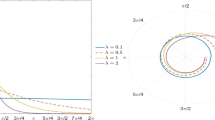Abstract
In this paper, we investigate change-point problems for the number of modes in circular data. We use a mixture of two circular normal distributions to model the observed data. Tests for detecting the presence of change-point are derived using the generalized likelihood-ratio method. Asymptotic distributions of the test statistics are obtained. Results of some simulation studies are also presented.






Similar content being viewed by others
References
Aghaeepour N, Finak G, The FlowCAP Consortium, The DREAM Consortium, Hoos H, Mosmann TR, Brinkman R, Gottardo R, Scheuermann RH (2013) Critical assessment of automated flow cytometry data analysis techniques. Nat Methods 10(3):228–238
Basu S, Jammalamadaka SR (2002) Unimodality in circular data: A Bayes test. In: Balakrishnan N (ed) Advances on methodological and applied aspects of probability and statistics. Taylor and Francis, New York, pp 141–153
Batschelet E (1981) Circular statistics in biology. Academic Press, London
Fisher NI (1995) Statistical analysis of circular data. Cambridge University Press, Cambridge
Ghosh K, Jammalamadaka SR, Vasudaven M (1999) Change-point problems for the von Mises distribution. J Appl Stat 26(4):423–434
Ho HJ, Lin TI, Chang HH, Haase SB, Huang S, Pyne S (2012) Parametric modeling of cellular state transitions as measured with flow cytometry. BMC Bioinform 13(Suppl 5):S5
Holzmann H, Vollmer S (2008) A likelihood ratio test for bimodality in two-component mixtures with application to regional income distribution in the EU. AStA Adv Stat Anal 92(1):57–69. https://doi.org/10.1007/s10182-008-0057-2
Jammalamadaka SR, SenGupta A (2001) Topics in circular statistics. World Scientific, Singapore
Landler L, Ruxton GD, Malkemper EP (2018) Circular data in biology: advice for effectively implementing statistical procedures. Behav Ecol Sociobiol 72(128):1–10
Mardia KV, Jupp PE (2000) Directional statistics. Wiley, Hoboken
Mardia KV, Sutton TW (1975) On the modes of a mixture of two von Mises distributions. Biometrika 62(3):699–701
Pyne S, Hu X, Wang K, Rossin E, Lin TI, Maier LM, Baecher-Allan C, McLachlan GJ, Tamayo P, Hafler DA, De Jager PL, Mesirov JP (2009) Automated high-dimensional flow cytometric data analysis. Proc Natl Acad Sci 106(21):8519–8524
Acknowledgements
The authors would like to thank the referee, whose valuable comments have helped improve the presentation of the paper.
Author information
Authors and Affiliations
Corresponding author
Ethics declarations
Conflicts of interest
On behalf of all authors, the corresponding author states that there is no conflict of interest.
Additional information
Publisher's Note
Springer Nature remains neutral with regard to jurisdictional claims in published maps and institutional affiliations.
Rights and permissions
About this article
Cite this article
Ghosh, K., Nava, M.M. Detecting Change in the Number of Modes for Circular Data. J Stat Theory Pract 15, 32 (2021). https://doi.org/10.1007/s42519-021-00166-3
Accepted:
Published:
DOI: https://doi.org/10.1007/s42519-021-00166-3




